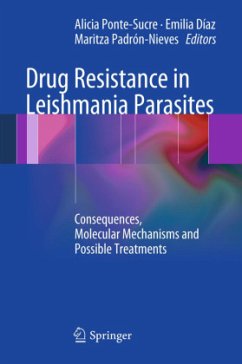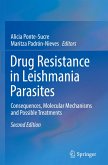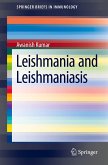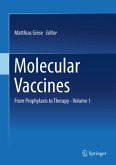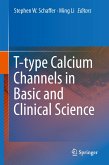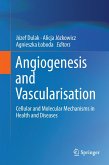Drug Resistance in Leishmania Parasites
Consequences, Molecular Mechanisms and Possible Treatments
Herausgegeben:Ponte-Sucre, Alicia; Diaz, Emilia; Padrón-Nieves, Maritza
Drug Resistance in Leishmania Parasites
Consequences, Molecular Mechanisms and Possible Treatments
Herausgegeben:Ponte-Sucre, Alicia; Diaz, Emilia; Padrón-Nieves, Maritza
- Gebundenes Buch
- Merkliste
- Auf die Merkliste
- Bewerten Bewerten
- Teilen
- Produkt teilen
- Produkterinnerung
- Produkterinnerung
One of the main problems concerning therapeutic tools for the treatment of parasitic diseases, including leishmaniasis, is that some field parasites are naturally resistant to the classical drugs; additionally, current therapies used may select parasites prone to be resistant to the applied drugs. These features are (at least partially) responsible for the disappointing persistence of the disease and resultant deaths worldwide. This book provides a comprehensive view of the pathology of the disease itself, and of parasitic drug resistance, its molecular basis, consequences and possible…mehr
Andere Kunden interessierten sich auch für
![Drug Resistance in Leishmania Parasites Drug Resistance in Leishmania Parasites]() Drug Resistance in Leishmania Parasites75,99 €
Drug Resistance in Leishmania Parasites75,99 €![Leishmania and Leishmaniasis Leishmania and Leishmaniasis]() Awanish KumarLeishmania and Leishmaniasis38,99 €
Awanish KumarLeishmania and Leishmaniasis38,99 €![Molecular Vaccines Molecular Vaccines]() Molecular Vaccines113,99 €
Molecular Vaccines113,99 €![Vaccines for Neglected Pathogens: Strategies, Achievements and Challenges Vaccines for Neglected Pathogens: Strategies, Achievements and Challenges]() Vaccines for Neglected Pathogens: Strategies, Achievements and Challenges30,99 €
Vaccines for Neglected Pathogens: Strategies, Achievements and Challenges30,99 €![Vaccines for Neglected Pathogens: Strategies, Achievements and Challenges Vaccines for Neglected Pathogens: Strategies, Achievements and Challenges]() Vaccines for Neglected Pathogens: Strategies, Achievements and Challenges38,99 €
Vaccines for Neglected Pathogens: Strategies, Achievements and Challenges38,99 €![T-type Calcium Channels in Basic and Clinical Science T-type Calcium Channels in Basic and Clinical Science]() T-type Calcium Channels in Basic and Clinical Science75,99 €
T-type Calcium Channels in Basic and Clinical Science75,99 €![Angiogenesis and Vascularisation Angiogenesis and Vascularisation]() Angiogenesis and Vascularisation112,99 €
Angiogenesis and Vascularisation112,99 €-
-
-
One of the main problems concerning therapeutic tools for the treatment of parasitic diseases, including leishmaniasis, is that some field parasites are naturally resistant to the classical drugs; additionally, current therapies used may select parasites prone to be resistant to the applied drugs. These features are (at least partially) responsible for the disappointing persistence of the disease and resultant deaths worldwide. This book provides a comprehensive view of the pathology of the disease itself, and of parasitic drug resistance, its molecular basis, consequences and possible treatments. Scientists both from academic fields and from the industry involved in biomedical research and drug design, will find in this book a valuable and fundamental guide that conveys the knowledge needed to understand and to improve the success in combating this disease worldwide.
Produktdetails
- Produktdetails
- Verlag: Springer / Springer Vienna / Springer, Wien
- Artikelnr. des Verlages: 80011344, 978-3-7091-0238-1
- 2013
- Seitenzahl: 476
- Erscheinungstermin: 4. September 2012
- Englisch
- Abmessung: 241mm x 160mm x 30mm
- Gewicht: 905g
- ISBN-13: 9783709102381
- ISBN-10: 3709102383
- Artikelnr.: 29381266
- Herstellerkennzeichnung Die Herstellerinformationen sind derzeit nicht verfügbar.
- Verlag: Springer / Springer Vienna / Springer, Wien
- Artikelnr. des Verlages: 80011344, 978-3-7091-0238-1
- 2013
- Seitenzahl: 476
- Erscheinungstermin: 4. September 2012
- Englisch
- Abmessung: 241mm x 160mm x 30mm
- Gewicht: 905g
- ISBN-13: 9783709102381
- ISBN-10: 3709102383
- Artikelnr.: 29381266
- Herstellerkennzeichnung Die Herstellerinformationen sind derzeit nicht verfügbar.
Professor Dr. Emilia Diaz Emilia Diaz studied Pharmacy at the Central University of Venezuela (UCV) in Caracas and became Doctor of Sciences in Pharmacology in 2003 in the same university. From 1999 to 2003 she was Assistant Professor at the Chair of Biology, Faculty of Pharmacy, UCV. Currently she is Aggregate Professor of Human Physiology, Faculty of Medicine, UCV. Initially her research interests were related to the comprehension of the mechanisms involved in the diuretic and natriuretic action of adrenomedullin, and the role of the dopaminergic system in the adrenomedullin-induced diuresis and natriuresis. Recently her research interests are focused towards the comprehension of the mechanisms involved in proficiency and fitness in drug resistant Leishmania and in the initial interaction events (chemotaxis) occurring between Leishmania and its host cell. Professor Dr. Maritza Padrón Nieves Maritza Padrón Nieves studied Biology at UCV in Caracas and became Magister Scientiarum in Pharmacology in 1993 and Doctor of Sciences in Pharmacology in 2011 in the same university. From 1994 to 2000 she was head of the Department of Basic Sciences at the School of Nursery, UCV. Currently she is Aggregate Professor and head of the Human Pharmacology and Toxicology Chair, Faculty of Medicine, UCV. Initially her research interests were related to the comprehension of the mechanisms involved in digoxin intoxication. Recently she has dedicated her scientific interest to the identification and characterization of molecular markers of resistance in the Leishmania sp. infection model. Professor Dr. Alicia Ponte-Sucre Alicia Ponte-Sucre studied Education in Biological Sciences at the Andrés Bello Catholic University in Caracas and became Magister Scientiarum in Physiology and Biophysics in 1981 at the Venezuelan Institute ofScientific Research and Doctor of Sciences in Pharmacology in 1993 at the UCV. She spent a year (1999-2000) at the University of Würzburg with a scholarship from the Alexander von Humboldt Foundation and was a staff scientist (2003-2007) at the same university, within a multidisciplinary project from the German Research Council. Currently she is Full Professor in Human Physiology and Coordinator for Scientific Affairs of the Faculty of Medicine, UCV. Initially, her studies were focused on the physical-chemical behavior of black lipid membranes. Later, her scientific activity was oriented towards the characterization of receptors involved in air-way smooth muscle contraction. Recently her interests have been focused towards the study of parasite metabolism and membrane transporters essential for parasite survival and involved in drug resistance, and the mechanisms involved in cellular differentiation and parasite-host interaction in the Leishmania model. Additionally she has characterized natural products and target oriented designed compounds as potential therapeutic agents.
Foreword.- Introduction. Leishmaniasis, the biology of a parasite. Alicia Ponte Sucre.- I Determinant features in leishmaniasis.- 1 Molecular evolution and phylogeny of Leishmania. Gabriele Schoenian, Elisa Cupolillo, Isabel Mauricio.- 2 The role of reservoirs: Canine leishmaniasis. Lenea Campino, Carla Maia.- 3 Epidemiology of leishmaniasis in the time of drug resistance. Jean Claude Dujardin, Saskya Decuypere.- II Leishmania and the immune system.- 4 The role of the immune system in resistance to infection. Lukasz Kedzierski, Krystal J. Evans.- 5 Vaccination as a control measure. Katrin Färber , Heidrun Moll.- 6 Leishmania vaccines: Past, Present and Future. Bhavana Sethu Lakshmi, Rentala Madhubala.- III Challenges in the diagnosis, treatment and control of leishmaniasis in times of drug resistance.- 7 Co-infection with HIV. Margriet den Boer, Luis Rivas, Jorge Alvar.- 8 Visceral leishmaniasis. Shyam Sundar , J aya Chakravarty.- 9 American Tegumentary leishmaniasis. Olga Zerpa, Alicia Ponte-Sucre.- IV Molecular features of drug-resistant Leishmania.- 10 Genetic expression and drug resistance, the role of proteomics. Patricia Cuervo, Jose Batista de Jesus.- 11 The role of ABC transporters in drug-resistant Leishmania. Adriano C Coelho, Paulo C Cotrim.- 12 Functional analysis of Leishmania membrane (non ABC) transporters involved in drug resistance. Scott M Landfear.- 13 Intracellular mechanisms of resistance in Leishmania.- V Pharmacology and chemotherapy of leishmaniasis. Mitali Chatterjee.- 14 Classical vs new Treatment regimens. Louis Maes, Raquel Andreia Inocencio da Luz, Paul Cos, Vanessa Yardley.- 15 Drug targets, drug effectors and drug targeting and delivery. Philippe M Loiseau, Gillian Barratt.- 16 Mechanisms of miltefosineresistance in Leishmania. Francisco Gamarro, María P Sánchez-Cañete, Santiago Castanys.- 17 P-glycoprotein-like transporters in Leishmania: a search for reversal agents. Bruno Pradines.- VI Strategies to circumvent drug resistance in Leishmania.- 18 The relevance of susceptibility tests, breakpoints and markers. Louis Maes, Paul Cos and Simon Croft.- 19 The Concept of Fitness and drug resistance in Leishmania. Alicia Ponte-Sucre, Emilia Diaz, Maritza Padrón-Nieves.
Foreword.- Introduction. Leishmaniasis, the biology of a parasite. Alicia Ponte Sucre.- I Determinant features in leishmaniasis.- 1 Molecular evolution and phylogeny of Leishmania. Gabriele Schoenian, Elisa Cupolillo, Isabel Mauricio.- 2 The role of reservoirs: Canine leishmaniasis. Lenea Campino, Carla Maia.- 3 Epidemiology of leishmaniasis in the time of drug resistance. Jean Claude Dujardin, Saskya Decuypere.- II Leishmania and the immune system.- 4 The role of the immune system in resistance to infection. Lukasz Kedzierski, Krystal J. Evans.- 5 Vaccination as a control measure. Katrin Färber , Heidrun Moll.- 6 Leishmania vaccines: Past, Present and Future. Bhavana Sethu Lakshmi, Rentala Madhubala.- III Challenges in the diagnosis, treatment and control of leishmaniasis in times of drug resistance.- 7 Co-infection with HIV. Margriet den Boer, Luis Rivas, Jorge Alvar.- 8 Visceral leishmaniasis. Shyam Sundar , J aya Chakravarty.- 9 American Tegumentary leishmaniasis. Olga Zerpa, Alicia Ponte-Sucre.- IV Molecular features of drug-resistant Leishmania.- 10 Genetic expression and drug resistance, the role of proteomics. Patricia Cuervo, Jose Batista de Jesus.- 11 The role of ABC transporters in drug-resistant Leishmania. Adriano C Coelho, Paulo C Cotrim.- 12 Functional analysis of Leishmania membrane (non ABC) transporters involved in drug resistance. Scott M Landfear.- 13 Intracellular mechanisms of resistance in Leishmania.- V Pharmacology and chemotherapy of leishmaniasis. Mitali Chatterjee.- 14 Classical vs new Treatment regimens. Louis Maes, Raquel Andreia Inocencio da Luz, Paul Cos, Vanessa Yardley.- 15 Drug targets, drug effectors and drug targeting and delivery. Philippe M Loiseau, Gillian Barratt.- 16 Mechanisms of miltefosineresistance in Leishmania. Francisco Gamarro, María P Sánchez-Cañete, Santiago Castanys.- 17 P-glycoprotein-like transporters in Leishmania: a search for reversal agents. Bruno Pradines.- VI Strategies to circumvent drug resistance in Leishmania.- 18 The relevance of susceptibility tests, breakpoints and markers. Louis Maes, Paul Cos and Simon Croft.- 19 The Concept of Fitness and drug resistance in Leishmania. Alicia Ponte-Sucre, Emilia Diaz, Maritza Padrón-Nieves.

